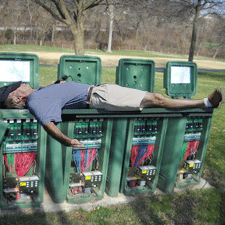While the U.S. Open and the U.S. Amateur share a date of birth (1895), the events have evolved to be quite different. The U.S. Open attracts major television viewers, huge galleries, large sponsor hospitality tents and intense media scrutiny. The U.S. Amateur, on the other hand, often slips by quietly in the month of August, overshadowed in today’s golf world by The FedEx Cup and the start of professional football. So in case you missed it, the 111th running of the U.S. Amateur concluded this past Sunday at Erin Hills Golf Course outside Milwaukee, Wisconsin with Kelly Kraft outlasting Patrick Cantlay 2-up on the 36th hole of the final.
Because of the lower profile nature of the U.S. Amateur there is less need to bring in all the accoutrements that come with all of that attention–fewer portable toilets, grandstands, concession tents, television towers, etc. But because of the national prominence of the event some of the players may confuse the issue and feel they should be entitled to the more generous relief that comes with these temporary obstructions that have been erected for the championship. Perhaps that is why I was asked by one of the contestants in this year’s championship for relief from an irrigation control box that was on his line of play.
During the first round of stroke play qualifying (315 players vying for the low 64 spots in the Match Play field) a young player from North Carolina hit his tee shot well right on the par-four second hole at Blue Mound Golf Course. (Blue Mound was serving as the supporting course for the Amateur this year, a role that the CGA/CWGA’s home course, CommonGround will serve in 2012 when the U.S. Amateur comes to Cherry Hills.) His ball came to rest under a tree and was so situated that his only play was a low punch shot back to the fairway.
Unfortunately, for this young man there was an irrigation control box blocking his intended line of play back to the fairway. Since the obstruction was not temporary (it was there long before the tournament was played and I am quite confident it is still there now) and since it was not close enough to the player’s ball to interfere with his stance, lie of ball or area of intended swing–no relief was available. The player asked for relief and I informed him that there was no interference from the obstruction. The player wasn’t particularly happy with me at that point and asked what the ruling would be if the control box were a scoreboard. In that case, as I informed the player, he would have been given relief as a scoreboard placed on the course for the championship is clearly a temporary immovable obstruction and interference would be expanded to include his “line of play.” The philosophy here is that those obstructions that are there all the time will be dealt with the same way they are dealt with every other day of the year. On the other hand, the impact of those obstructions that are there only during the championship should be minimized since they are not permanent. Since they are obstructions (albeit temporary) the Rule preserves the one-club length relief area (similar to permanent obstructions) once the player finds the point on the course that no longer interferes with the line of play.
Perhaps the next time I meet this talented player the circumstances will be different!


